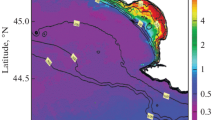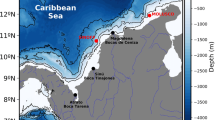Summary
The dispersion of recycled particulates in the complex coastal terrain surrounding Kangnung city, Korea was investigated using a three-dimensional non-hydrostatic numerical model and lagrangian particle model (or random walk model). The results show that particulates at the surface of the city that float to the top of thermal internal boundary layer (TIBL) are then transported along the eastern slope of the mountains with the sea breeze passage and nearly reach the top of the mountains. Those particulates then disperse eastward at this upper level over the coastal sea and finally spread out over the open sea. Total suspended particulate (TSP) concentration near the surface of Kangnung city is very low. At night, synoptic scale westerly winds intensify due to the combined effect of the synoptic scale wind and land breeze descending the eastern slope of the mountains toward the coast and further seaward. This increase in speed causes development of internal gravity waves and a hydraulic jump up to a height of about 1 km above the surface over the city. Particulate matter near the top of the mountains also descends the eastern slope of the mountains during the day, reaching the central city area and merges near the surface inside the nocturnal surface inversion layer (NSIL) with a maximum ground level concentration of TSP occurring at 0300 LST. Some particulates are dispersed following the propagation area of internal gravity waves and others in the NSIL are transported eastward to the coastal sea surface, aided by the land breeze. The following morning, particulates dispersed over the coastal sea from the previous night, tend to return to the coastal city of Kangnung with the sea breeze, developing a recycling process and combine with emitted surface particulates during the morning. These processes result in much higher TSP concentration. In the late morning, those particulates float to the top of the TIBL by the intrusion of the sea breeze and the ground level TSP concentration in the city subsequently decreases.
Similar content being viewed by others
Author information
Authors and Affiliations
Rights and permissions
About this article
Cite this article
Choi, H., Zhang, Y. & Takahashi, S. Recycling of suspended particulates by the interaction of sea-land breeze circulation and complex coastal terrain. Meteorol Atmos Phys 87, 109–120 (2004). https://doi.org/10.1007/s00703-003-0064-5
Received:
Revised:
Accepted:
Published:
Issue Date:
DOI: https://doi.org/10.1007/s00703-003-0064-5




